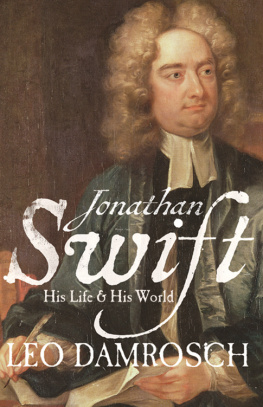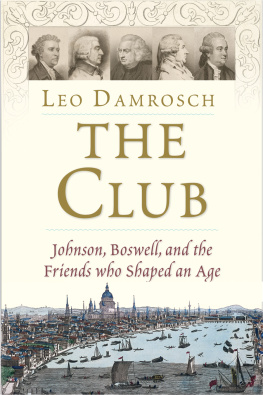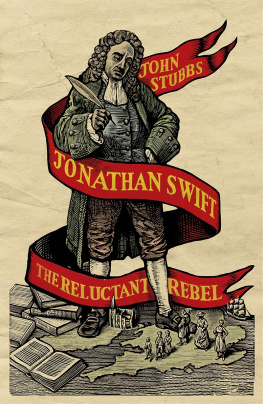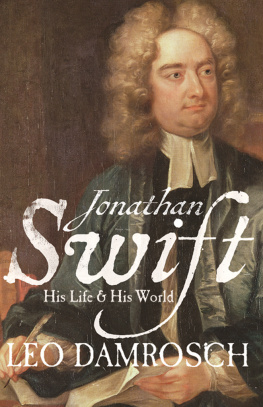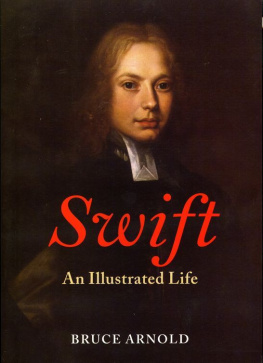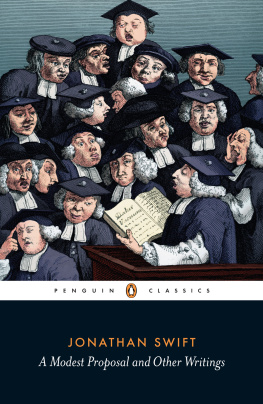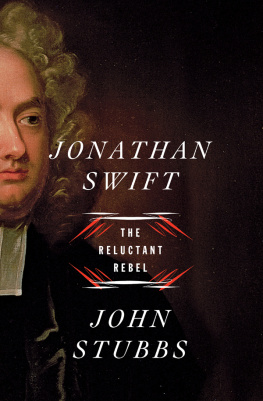Jonathan Swift
Jonathan Swift
HIS LIFE AND HIS WORLD
Leo Damrosch
Yale UNIVERSITY PRESS
New Haven and London
Published with assistance from the Annie Burr Lewis Fund and from the foundation established in memory of Philip Hamilton McMillan of the Class of 1894, Yale College.
Copyright 2013 by Leo Damrosch. All rights reserved. This book may not be reproduced, in whole or in part, including illustrations, in any form (beyond that copying permitted by Sections 107 and 108 of the US Copyright Law and except by reviewers for the public press), without written permission from the publishers.
Yale University Press books may be purchased in quantity for educational, business, or promotional use. For information, please e-mail (UK office).
Designed by Nancy Ovedovitz and set in Adobe Garamond type by Newgen North America. Printed in the United States of America.
Library of Congress Cataloging-in-Publication Data
Damrosch, Leopold.
Jonathan Swift : his life and his world / Leo Damrosch.
pages cm.
Includes bibliographical references and index.
ISBN 978-0-300-16499-2 (clothbound : alk. paper)
1. Swift, Jonathan, 16671745. 2. Authors, lrish18th centuryBiography. I. Title
PR3726.D27 2013
828.509dc23
[B]
A catalogue record for this book is available from the British Library.
This paper meets the requirements of ANSI/NISO Z39.481992 (Permanence of Paper).
10 9 8 7 6 5 4 3 2 1
Contents
Illustrations
Acknowledgments
I want to express my gratitude to Robin Dublanc, expert copyeditor; to Jennifer Banks, whose editorial insight was invaluable in shaping this story; and to Joyce Van Dyke, whose imagination and advice improved every page of the book. My research and the acquisition of illustrations were generously supported by a grant from the Andrew W. Mellon Foundation.
Prologue
In the 1720s a brilliant and beautiful young woman was entangled in a troubled affair with a man twenty years older. She had fallen passionately in love with him in London, and when he moved home to Dublin she followed him there. He was strongly attracted to her but reluctant to commit himself, and he insisted they keep their relationship secret. They were apart much of the time and communicated by letter, and she was sometimes near despair when he seemed to be rejecting her: I am sure I could have bore the rack much better than those killing, killing words of yours. At other times, though, he did reply in the way she wanted. Be assured, he declared, that no one on earth has ever been loved, honored, esteemed, adored by your friend but yourself. Whenever he wrote like that, she would be joyfulYou are good beyond expression, and I will never quarrel again if I can help it. For a time they met covertly once a week at someone elses house in Dublin.
In the letters they had a private code. The man suggested that a stroke thus signifies everything that may be said. In her letters from then on, the dashes flew thick and fast: I have worn out my days in sighing and my nights with watching and thinking of , , , . Only they knew what words were meant.
Evidently, the word coffee was part of the same code. In a number of letters from the man over several years, coffee has a suggestive aura: I wish I were to walk with you fifty times about your garden, and thendrink your coffee;
The man in this strange romantic story was Jonathan Swift, and the book he was trying to write was Gullivers Travels. He liked to be mysterious toward everyone, not just toward the young woman, and even those who knew him best were baffled by his contradictions. One friend said that his character was exceedingly strange, various, and perplexed, and another called him my hieroglyphic friend. He became a public figure of great distinction, dean of St. Patricks Cathedral, and a champion of Irish rights, yet he was profoundly skeptical and he claimed to despise Ireland. He was a great writer, yet he almost never signed his name to his work.
Even the basic facts concerning Swifts origins are open to question. He inherited the name of a Jonathan Swift who died before he was born, but it is not entirely certain that that was his real father. His wet nurse abducted him from Dublin when he was an infant and took him to England with her; amazingly, his family let him stay there with her for several years. Why? When he was finally brought back to Dublin, why did his mother then leave for England herself, and why did he not see her again until he was an adult? After his mother left, an uncle in Dublin become his guardian and paid for an expensive education. So why did Swift despise his uncle and declare that he had been given the education of a dog?
It wasnt just Swifts childhood that was mysterious; his most intimate and enduring adult relationships were mysterious too. After college he spent ten years as confidential secretary to a distinguished retired diplomat in England in whose household there was a bright nine-year-old girl, the housekeepers daughter. The diplomat arranged to have his servants child tutored by Swift, and at his death she received an extraordinarily large bequest. As an adult she became Swifts closest friend for the rest of her life, and she too moved to Dublin when he returned there. Even though they were apparently never together without a third party present, many who knew them were convinced that they were secretly married. But if they were married, why did it have to be secret? And how much did the close friend (or wife) know about her young rival with the coffee? Was it an actual love triangle, or only a virtual one?
To this day, at least two dozen publishers are keeping it in print, and it is a universal classic, its fame extending beyond the English-speaking world.
But few know much about the man who wrote Gullivers Travels, or about the long-ago world that for him was the present moment. This book is an invitation to time travel, in quest of what a historian has called the sensations of being alive in a different time. Swift was alive during a time of revolutionary
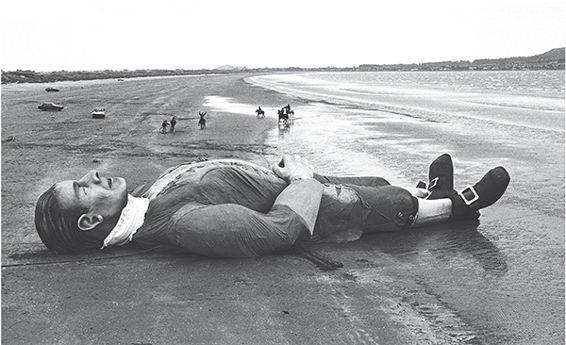
1. Gulliver on Dollymount Strand. A seventy-foot fiberglass model of Gulliver in Lilliput, constructed to correct scale, just east of Dublin. Swift would have loved this picture, not to mention the effigy, since he often rode his horse on this beach.
Swift was known as a great talker. Unlike Samuel Johnson, described by Boswell as talking for victory, and determined to be master of the field, Swift was open and relaxed in conversation. And although his flow of humor was noted by everyone who knew him, it seldom took the form, as Johnsons did, of quotable bon mots. He was by no means in the class with those, his relative Deane Swift said, who pour down their eloquence like a torrent, driving all before it. Far from any desires of that sort, he equally loved to speak, and loved to hearken.
Something of Swifts style of talking comes through in his letters, often playful, at times angry. He complained to a former patron that he was wasting away in Ireland, and expected to die there in a rage, like a poisoned rat in a hole. Especially revealing is the daily journal he kept during one extended period, sent in installments to the woman who was his closest friend, and whom he may have secretly married. He had a wonderful ear for the way people talk, and he loved to act out and impersonate: I dined today with Patty Rolt at my cousin Leachs, with a pox, in the city. He is a printer, and prints the Postman, oh ho, and is my cousin, God knows how, and he married Mrs. Baby Aires of Leicester.... I wish you could hear me repeating all I have said of this in its proper tone, just as I am writing it. Tis all with the same cadence with oh hoo, or as when little girls say, I have got an apple, miss, and I wont give you some.
Next page
